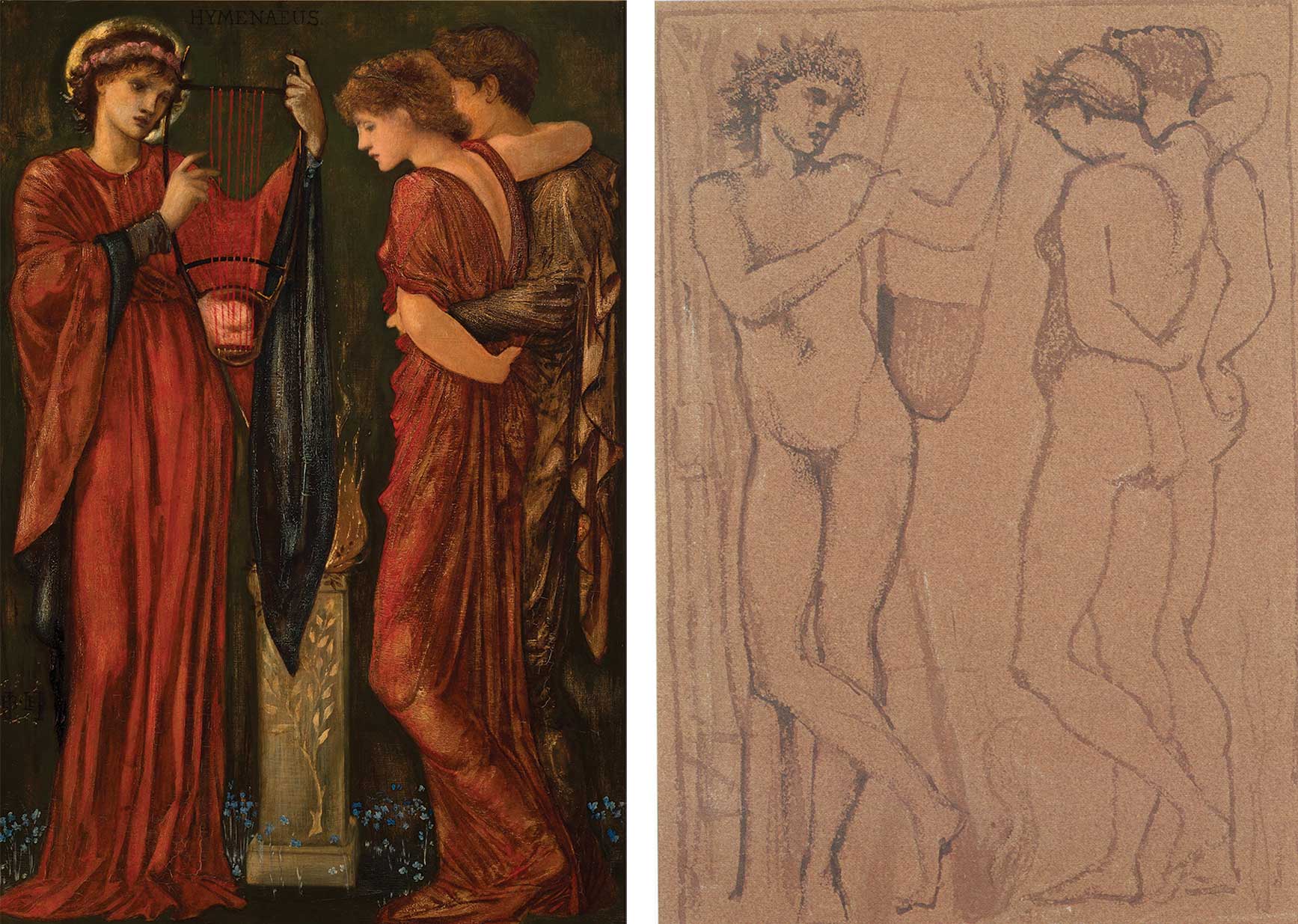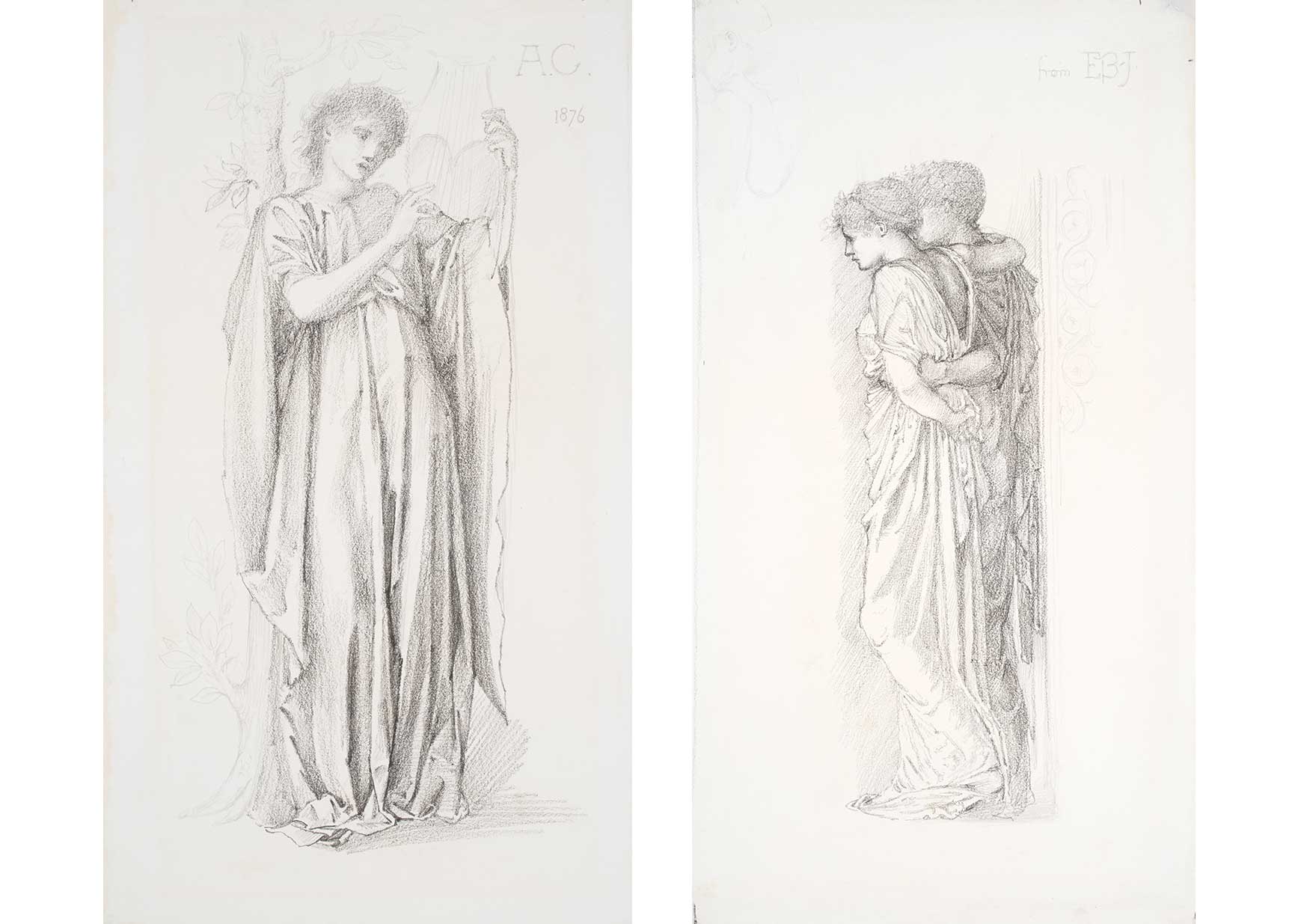ILL. #1 Top, left to right: Hymen, the goddess of marriage holding a harp; A Married couple being blessed, 1876. Edward Burne Jones (1833–1898). Graphite on paper laid on card, 13 3/4 x 8 1/8 inches (top), 14 1/16 x 7 7/8 inches (bottom). Delaware Art Museum, F. V. du Pont Acquisition Fund, 2019.
The Museum was recently able to purchase two drawings [ILL. #1], which served as preparatory sketches for our painting of Hymenaeus [ILL. #2] (1869, oil over gold leaf on panel) by the Pre-Raphaelite artist Edward Burne-Jones (1833-1898). In the painting, Hymen, goddess of marriage, is shown at left, blessing the nuptials of the couple on the right. In the drawings, the three figures are split between the two sheets of paper, allowing the artist to work out the individual poses. Certain details which appear in the final painting are not included in the drawings. For instance, the harp held by Hymen is only partially sketched in and the flame-bearing altar, which serves to separate goddess from couple in the painting, is omitted in the earlier drawings.
In the late 1860 and early 1870s Burne-Jones took up the theme of marriage in a number of drawings and paintings. The earliest, now in the Tate Gallery, The Temple of Love, begun in 1868 but left unfinished, depicts a young couple standing before an altar as the goddess of love kneels down to bless them. Some years later, a watercolor drawing, heightened with gold, entitled The Altar of Hymen (1874) was executed. This composition is more closely related to the Museum’s painting as the couple is placed in the foreground with the altar and flame to the left. The winged figure of Cupid stands next to Venus at the upper right, in what also looks to be a temple setting. Hymen’s harp is first depicted in an otherwise unrelated composition entitled The Sacrifice to Hymen. Of particular interest in relation to the two recently purchased drawings is a quickly executed, charcoal and wash drawing on brown paper [ILL. #3] which is quite similar in composition to the Museum’s painting, and executed on a single sheet Although nowhere near as finished as the Museum’s new drawings, the artist has clearly developed the arrangement of figures and poses. This is particularly clear in the depiction of the couple, whose tenderly entwined arms reflect their profound love.
 ILL. #2 Hymenaeus, 1869. Edward Burne-Jones (1833–1898). Oil paint over gold leaf on panel, 32 1/4 x 21 1/2 inches, frame: 36 x 49 1/2 inches. Delaware Art Museum, Samuel and Mary R. Bancroft Memorial, 1935. ILL. #3 Study for Hymenaeus, undated. Edward Burne-Jones (1833–1898). Charcoal and wash on brown paper. Private collection.
ILL. #2 Hymenaeus, 1869. Edward Burne-Jones (1833–1898). Oil paint over gold leaf on panel, 32 1/4 x 21 1/2 inches, frame: 36 x 49 1/2 inches. Delaware Art Museum, Samuel and Mary R. Bancroft Memorial, 1935. ILL. #3 Study for Hymenaeus, undated. Edward Burne-Jones (1833–1898). Charcoal and wash on brown paper. Private collection.
Burne-Jones created the painting as a wedding gift to his close friend and patron Luke Ionides and his bride, Elfida Bird who were married in August 1869. Several years later, as indicated by the inscription and date at upper right and left respectively, the preliminary drawings were given to artist and writer Agnes Graham, later Dame Agnes Jekyll. Agnes was the daughter of William Graham, a devoted patron of the Pre-Raphaelites and loyal friend to Burne-Jones. The artist became quite fond of Graham’s daughters as expressed in substantial correspondence. William Graham was a passionate collector of Italian Renaissance art as well as that of Burne-Jones and the Pre-Raphaelites. His enthusiasm for quattrocento painting, which was shared by Burne-Jones contributed to the strength of the relationship between artist and patron. In 1876 (the date of the inscription on the drawings) the Graham family were touring Italy. Burne-Jones wrote a series of letters to Agnes, advising her on what to see amongst the Renaissance treasures in the country. The letters suggest a mentor-student relationship (he addresses her as “dear little Aggie”) in which the artist strives to instill an appreciation for Florentine art in particular — “I try to remember what things in Florence you might miss…” Burne-Jones loved children and his letters reflect a playful relationship with Agnes. Of Santa Maria Novella, he wrote, “…there are 2 little old pussycats called Missies Forbes — the Twa Forbies I call them, countrywomen of yours [the Graham’s were Scottish], who live in Florence & they would show you every nook & corner & the last Botticelli fragment found on the walls of a house.”
The two drawings stayed in the Graham family, passed down from one generation to the next, until they were recently offered for sale, at which time they were acquired by the Museum. They can be seen in the Pre-Raphaelite galleries hanging nearby the painting.
Margaretta Frederick
Annette Woolard-Provine Curator of the Bancroft Collection

